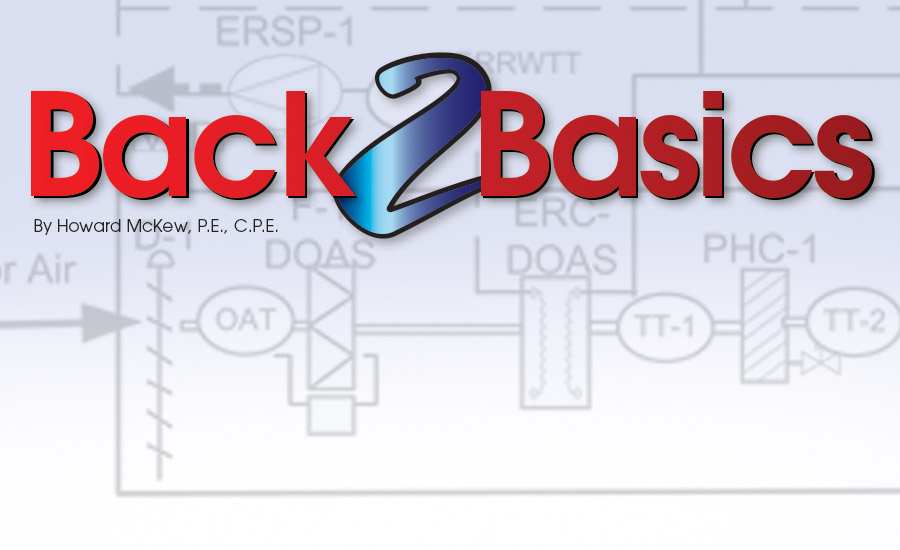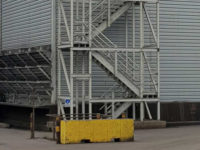This month’s B2B focuses on a new cooling tower to serve a pharmaceutical facility’s new process water system. This tower will be a closed-loop, evaporative condenser to operate 24/7/365. The pharma company’s design intent is to produce 100 tons of capacity while maintaining a clean and reliable system loop for the process equipment. The tower will have a floor-mounted end suction condenser water pump, and a second pump will serve as standby. The pumps shall each have a VFD to respond to the variation in flow to the 20-process equipment heat exchangers, each with two-way modulating automatic temperature control (ATC) valves. The tower shall also have two variable-speed, forced-draft fans to provide additional fan capacity should one fan fail.
The benefits of the closed-loop process cooling system include:
- A continuously maintained clean process/condenser water fluid via the closed-loop piping system;
- A closed-loop system that offers high-efficiency, clean, sustained performance;
- “Free cooling” operation during the condenser water heating season;
- Reduced energy consumption by operating the fan and process water pump at variable speed; and
- Redundancy in tower fans, condenser/process water pumps, and VFDs.
The design team shall be led by the HVAC engineer with structural, plumbing, and electrical consultants. The manufacturer engineer will provide guidance on the prepurchased process equipment. The project delivery method shall be construction management in accordance with the Construction Management Association of America (CMAA). The design team, along with the construction manager (CM) project manager, shall include the pharma capital project manager; building facility manager; and third-party commissioning (Cx) and testing, adjusting, and balancing (TAB) water balancing (CxTAB) consultant. The building’s facility manager and her operating and maintenance (O&M) staff, including the building automation system (BAS) operator, will also participate in the CM process beginning at the conceptual design phase.
The design engineer directs the owner’s in-house team and the CM’s in-house team to 2016 ASHRAE Handbook – HVAC Systems and Equipment Chapter 1, HVAC System Analysis and Selection, to determine the optimum cooling tower application for this special pharma equipment line. In addition, the owner and builder are also directed to Chapter 14, Condenser Water Systems, and Chapter 41, Evaporative Air-Cooling Equipment, of the handbook. The design team, owner’s team, and CM should review the Cooling Technology Institute’s (CTI’s) cooling tower manual and the CTI certification criteria as part of the project delivery process. Also part of the development of the design intent, the project will take into account 2019 ASHRAE Handbook – HVAC Applications, Chapters 37-44, covering building operation and management.
The design team and CM firm shall begin to come together at the Conceptual Phase of the design, working closely with the process equipment engineer and the facility management staff. The third-party CxTAB consultant will use the design team’s Basis of Design to begin the initial training of the operations and maintenance (O&M) personnel as it pertains to the process water system tower and pumping strategy.
Electrical shall be 480/3/60 with prewired electrical power to a new BAS ATC panel and to fan motors furnished with disconnects at the cooling tower. This contractor will also furnish starters and disconnects to the VFDs and pump motors. The HVAC subcontractor’s ATC subcontractor will work with the electrical subcontractor to interface the new process cooling tower system’s ATCs, including the 20-piece process equipment to the existing BAS.
At the end of this first phase of design, the CM will provide the initial project estimate. At the end of the Design Development Phase, the CM will provide a guaranteed maximum price (GMP) for the job. During the Construction Phase, the O&M staff shall follow along with the subcontractors when the process water system is started up, water balanced for normal operation, and lead-lag sequenced under a tower fan or condenser water/process water equipment failure. This O&M staff will observe the CM’s mechanical-electrical coordinator and automatic control subcontractor demonstrating the third-party CxTAB consultant’s functional performance test. The building’s BAS operator will also follow along with the design and construction process.
The CM team’s HVAC subcontractor shall include the following during the shop drawing submittal phase:
- Equipment submittals - A startup sheet - Troubleshooting sheets - A cooling tower performance testing process - O&M manuals, parts, and lubricants - An ATC and energy management submittal including one complete ATC submittal integrating the manufacturer’s cooling tower furnished ATC into an integrated overall ATC submittal.
The third-party CxTAB firm shall complete the following:
- A TAB system flow diagram of the entire new condenser/process water system with gpms and pumps heads indicated at each piece of new equipment.
- A TAB system flow diagram of the entire supply and return water system, drawing upon data from the design engineer’s hydraulic model with gpms and pressure drops at each piece of process cooling equipment and at major branch runouts.
- A commissioning functional performance test of the process system, including the cooling tower, circulating pumps, and process equipment.
Refer to The Facility File for additional information pertaining to completing the B2B test.





